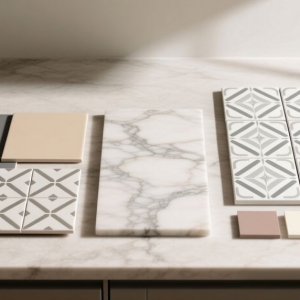A trip to a tile shop unveils a world of creative potential, with mosaic tiles standing out for their intricate designs and versatility. Among the top choices are ceramic, glass, and stone mosaic tiles, each offering distinct qualities that cater to different needs. Deciding which one is right for your project involves understanding their durability, maintenance requirements, cost, and aesthetic appeal, then aligning them with your vision.
Ceramic Mosaic Tiles: The All-Purpose Option
Ceramic mosaic tiles are a go-to in any tile shop, prized for their durability and adaptability. Available in a vast array of colors, patterns, and finishes, they can emulate high-end materials like stone or metal while remaining accessible. Whether you opt for a glossy finish that adds brightness or a matte texture for a softer look, ceramic offers endless design flexibility.
The biggest advantage of ceramic is its practicality. These tiles are tough, making them ideal for high-traffic areas like kitchen backsplashes, bathroom walls, or floors in moderate-use spaces. They’re easy to clean—most spills wipe away effortlessly—and they resist stains well. Plus, ceramic mosaic tiles are often the most budget-friendly option, allowing you to tackle larger projects without breaking the bank.
However, ceramic may not deliver the same visual intensity as glass or the natural texture of stone. It’s a dependable, cost-effective choice, but if you’re aiming for a bold or luxurious look, it might feel a bit too standard. For projects where functionality and affordability are key, though, ceramic shines.
Glass Mosaic Tiles: Sleek and Stunning
Glass mosaic tiles are designed to make an impact. Their reflective surfaces bounce light around a room, creating a bright, open feel that’s perfect for contemporary designs. You’ll often find them in bathrooms, pool areas, or as accent pieces in kitchens, where their glossy finish adds a touch of elegance. They’re especially effective in smaller spaces, as their light-reflecting quality can make rooms feel more spacious.
Glass tiles are also practical for wet environments. Being non-porous, they resist water, stains, and discoloration, making them a great choice for showers or backsplashes. A quick wipe is usually all it takes to keep them looking pristine.
That said, glass has its limitations. It can be slippery when wet, so it’s not the best choice for floors in busy areas. It also shows smudges and fingerprints more easily than ceramic, requiring more frequent cleaning in high-touch spaces. Cost is another consideration—glass mosaic tiles are typically pricier, especially for intricate designs or large installations. For many, glass works best as an accent, paired with other mosaic tiles to add sparkle without overwhelming the budget.
Stone Mosaic Tiles: Natural Beauty
Stone mosaic tiles bring a sense of earthy elegance to any space. Crafted from materials like marble, slate, or travertine, they offer a rich texture and natural beauty that feel both timeless and luxurious. Whether used in a modern bathroom or a cozy kitchen, stone adds a sense of authenticity that’s hard to match.
The beauty of stone lies in its individuality. Each tile features unique variations in color, veining, and texture, creating a one-of-a-kind look. This makes stone ideal for those who want a space with personality, whether in a sleek, contemporary design or a rustic retreat.
The downside is maintenance. Stone is porous, meaning it can absorb liquids and stain if not properly sealed. Installation requires a sealant, and periodic resealing is needed to maintain protection. Stone is also heavier and more expensive than ceramic, and its installation can be more complex, requiring skilled labor. But for those who value its natural charm, the extra effort is a small price to pay.
Choosing the Best Mosaic Tiles for Your Project
The choice between ceramic, glass, and stone mosaic tiles hinges on your priorities. If you’re looking for an affordable, low-maintenance option, ceramic is hard to beat. If you want a bright, modern aesthetic, glass delivers a stunning effect. If you’re drawn to natural beauty and don’t mind extra upkeep, stone offers unmatched character.
Consider the space you’re designing. Glass tiles can brighten a small bathroom, making it feel more spacious. Ceramic is ideal for a busy kitchen where durability and easy cleaning are essential. Stone can add warmth and texture to a living room feature wall or an outdoor patio. Mixing materials—like using glass accents with a ceramic base or stone with subtle glass highlights—can create a dynamic, personalized look.
Tips for Navigating the Tile Shop
Before visiting a tile shop, define your project’s scope. Measure the space to estimate how many mosaic tiles you’ll need and budget for installation costs, which can vary by material. Think about maintenance—stone requires more care, while ceramic and glass are more forgiving. Also, consider the mood you want to create: sleek and shiny, warm and natural, or a blend of both.
Bring home samples from the tile shop to see how the tiles look in your space’s lighting. This can help you avoid costly mistakes and ensure the tiles complement your decor. If you’re mixing materials, experiment with layouts to find the perfect balance.
Final Thoughts
A tile shop is a playground for creativity, but the choices can feel daunting. Ceramic, glass, and stone mosaic tiles each offer unique advantages, from ceramic’s affordability to glass’s brilliance to stone’s natural allure. By focusing on your budget, lifestyle, and design vision, you can find the perfect fit. Whether you stick with one material or blend them creatively, the right mosaic tiles Singapore will transform your space into something truly yours.











